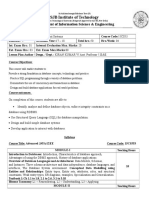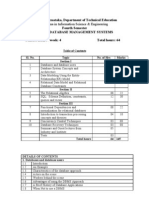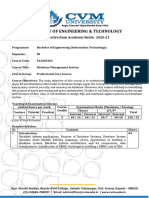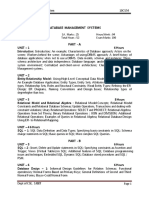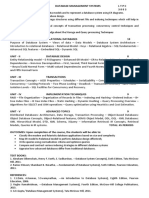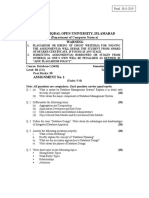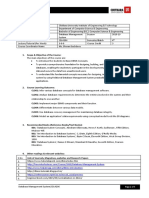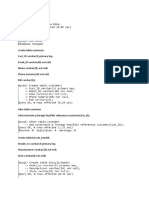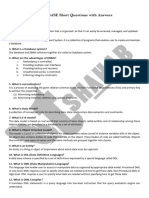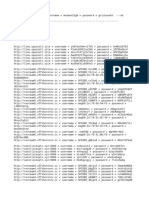SYLLABUS_SE_DBMS
Uploaded by
manthanballa08SYLLABUS_SE_DBMS
Uploaded by
manthanballa08Course Code: Course Title Credit
CSC403 Database Management System 3
Prerequisite: Data Structures
Course Objectives:
1 Develop entity relationship data model and its mapping to relational model
2 Learn relational algebra and Formulate SQL queries
3 Apply normalization techniques to normalize the database
4 Understand concept of transaction, concurrency control and recovery techniques.
Course Outcomes:
1 Recognize the need of database management system
2 Design ER and EER diagram for real life applications
3 Construct relational model and write relational algebra queries.
4 Formulate SQL queries
5 Apply the concept of normalization to relational database design.
6 Describe the concept of transaction, concurrency and recovery.
Module Content Hrs
1 Introduction Database Concepts 3
1.1 Introduction, Characteristics of databases, File system v/s Database system,
Data abstraction and data Independence, DBMS system architecture,
Database Administrator
2 Entity–Relationship Data Model 6
2.1 The Entity-Relationship (ER) Model: Entity types: Weak and strong entity
sets, Entity sets, Types of Attributes, Keys, Relationship constraints:
Cardinality and Participation, Extended Entity-Relationship (EER) Model:
Generalization, Specialization and Aggregation
3 Relational Model and relational Algebra 8
3.1 Introduction to the Relational Model, relational schema and concept of keys.
Mapping the ER and EER Model to the Relational Model, Relational
Algebra-operators, Relational Algebra Queries.
4 Structured Query Language (SQL) 6
4.1 Overview of SQL, Data Definition Commands, Integrity constraints: key
constraints, Domain Constraints, Referential integrity , check constraints,
Data Manipulation commands, Data Control commands, Set and string
operations, aggregate function-group by, having, Views in SQL, joins,
Nested and complex queries, Triggers
5 Relational-Database Design 6
5.1 Pitfalls in Relational-Database designs, Concept of normalization, Function
Dependencies, First Normal Form, 2NF, 3NF, BCNF.
6 Transactions Management and Concurrency and Recovery 10
6.1 Transaction concept, Transaction states, ACID properties, Transaction
Control Commands, Concurrent Executions, Serializability-Conflict and
View, Concurrency Control: Lock-based, Timestamp-based protocols,
Recovery System: Log based recovery, Deadlock handling
Textbooks:
1 Korth, Slberchatz, Sudarshan, Database System Concepts, 6thEdition, McGraw Hill
2 Elmasri and Navathe, Fundamentals of Database Systems, 5thEdition, Pearson Education
3 Raghu Ramkrishnan and Johannes Gehrke, Database Management Systems, TMH
References:
1 Peter Rob and Carlos Coronel, Database Systems Design, Implementation and
Management‖, Thomson Learning, 5thEdition.
2 Dr. P.S. Deshpande, SQL and PL/SQL for Oracle 10g, Black Book, Dreamtech Press.
3 G. K. Gupta, Database Management Systems, McGraw Hill, 2012
Assessment:
Internal Assessment:
Assessment consists of two class tests of 20 marks each. The first class test is to be conducted
when approx. 40% syllabus is completed and second class test when additional 40% syllabus is
completed. Duration of each test shall be one hour.
End Semester Theory Examination:
1 Question paper will comprise of total six questions.
2 All question carries equal marks
3 Questions will be mixed in nature (for example supposed Q.2 has part (a) from module 3
then part (b) will be from any module other than module 3)
4 Only Four question need to be solved.
5 In question paper weightage of each module will be proportional to number of respective
lecture hours as mention in the syllabus.
Useful Links
1 https://nptel.ac.in/courses/106/105/106105175/
2 https://swayam.gov.in/nd1_noc19_cs46/preview
3 https://www.classcentral.com/course/swayam-database-management-system-9914
4 https://www.mooc-list.com/tags/dbms
You might also like
- Complete Download Handbook of Research on Business Process Modeling Handbook of Research On 1st Edition Jorge Cardoso PDF All Chapters100% (7)Complete Download Handbook of Research on Business Process Modeling Handbook of Research On 1st Edition Jorge Cardoso PDF All Chapters82 pages
- DBMS CSE Digital Notes 2020-2021 - March 9th 2021No ratings yetDBMS CSE Digital Notes 2020-2021 - March 9th 2021155 pages
- Annexure-II- Teaching Plan(CS237)-SushmaVankhedeNo ratings yetAnnexure-II- Teaching Plan(CS237)-SushmaVankhede4 pages
- Databases: DSIC. Academic Year 2010-2011No ratings yetDatabases: DSIC. Academic Year 2010-201119 pages
- COMPS-SE-IV-DBMS tt1-syllabus-2024-25_075953No ratings yetCOMPS-SE-IV-DBMS tt1-syllabus-2024-25_0759535 pages
- Cse V Database Management Systems 10cs54 NotesNo ratings yetCse V Database Management Systems 10cs54 Notes115 pages
- ECEG-4191: Module Data Storage and AnalysisNo ratings yetECEG-4191: Module Data Storage and Analysis6 pages
- UG - B.Sc. - Computer Science - 130 52 - BSc-Computer Science - Semester V - RDBMS - 8693100% (1)UG - B.Sc. - Computer Science - 130 52 - BSc-Computer Science - Semester V - RDBMS - 8693364 pages
- Database Syllabus: I. Course InformationNo ratings yetDatabase Syllabus: I. Course Information6 pages
- Fundamentals of Database Systems Course OutlineNo ratings yetFundamentals of Database Systems Course Outline3 pages
- Dbms r16 Syllabus of Jntuk and Its Structure0% (1)Dbms r16 Syllabus of Jntuk and Its Structure4 pages
- Iswe103l Database-Systems TH 1.0 71 Iswe103lNo ratings yetIswe103l Database-Systems TH 1.0 71 Iswe103l2 pages
- B. Sc. (Information Technology) Semester - IIINo ratings yetB. Sc. (Information Technology) Semester - III2 pages
- Database Design with SQL: Building Fast and Reliable SystemsFrom EverandDatabase Design with SQL: Building Fast and Reliable SystemsNo ratings yet
- Object-Relational Mapping Concepts and Techniques: Definitive Reference for Developers and EngineersFrom EverandObject-Relational Mapping Concepts and Techniques: Definitive Reference for Developers and EngineersNo ratings yet
- SQL Fundamentals for New Developers: A Practical Guide with ExamplesFrom EverandSQL Fundamentals for New Developers: A Practical Guide with ExamplesNo ratings yet
- Centre for Distance and online Education (CDOE)No ratings yetCentre for Distance and online Education (CDOE)2 pages
- Unit-2 Relational Model & Normalization(1NF 2NF 3NF BCNF)No ratings yetUnit-2 Relational Model & Normalization(1NF 2NF 3NF BCNF)42 pages
- Domain Constraints, Relational Database SchemasNo ratings yetDomain Constraints, Relational Database Schemas17 pages
- EDM - E1 - Data Architecture and Modeling - Normalization v1.1No ratings yetEDM - E1 - Data Architecture and Modeling - Normalization v1.160 pages
- 985 Structural Equation Modeling in Educational Research100% (1)985 Structural Equation Modeling in Educational Research39 pages
- PGDM BATCH 24-26 Database Management SystemNo ratings yetPGDM BATCH 24-26 Database Management System3 pages
- What is Data Modeling _ Introduction for Business AnalystsNo ratings yetWhat is Data Modeling _ Introduction for Business Analysts7 pages

